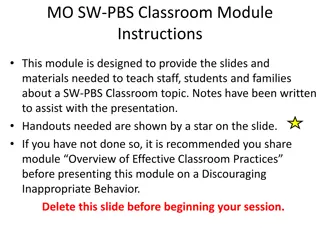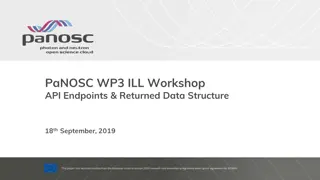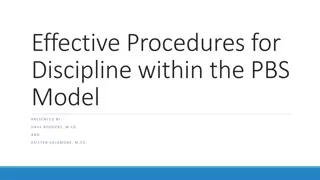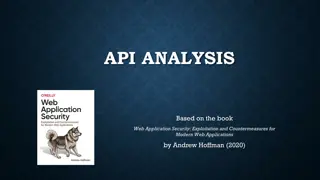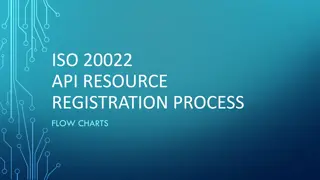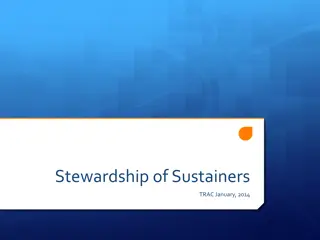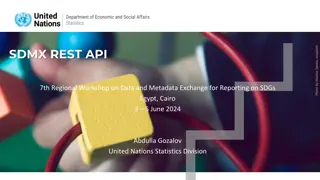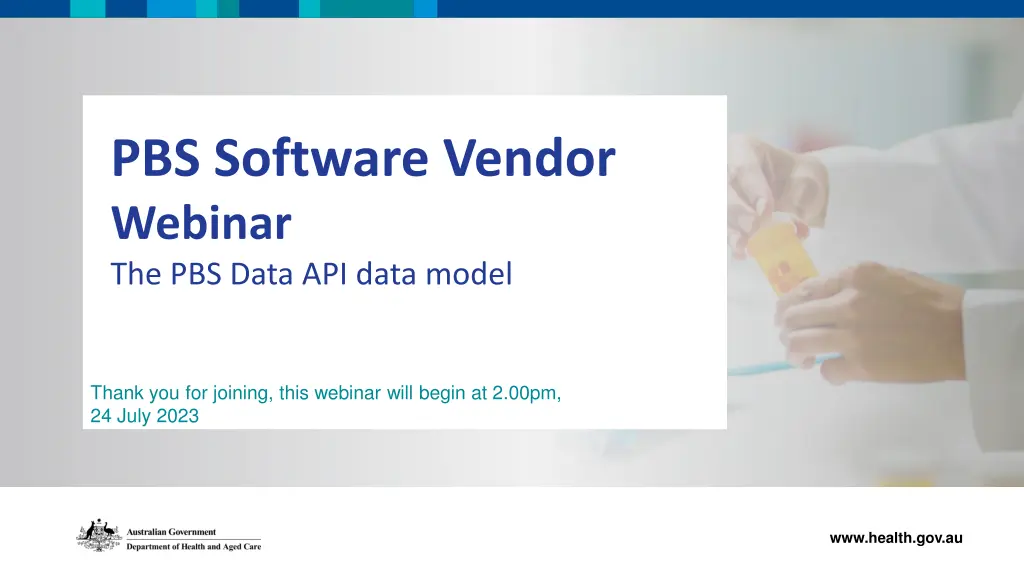
Modernising PBS Data Distribution Project with API Model
"Explore the Department of Health's initiative in modernising PBS data distribution through a relational API model. Learn about the background, data model structure, and key features of the project."
Download Presentation

Please find below an Image/Link to download the presentation.
The content on the website is provided AS IS for your information and personal use only. It may not be sold, licensed, or shared on other websites without obtaining consent from the author. If you encounter any issues during the download, it is possible that the publisher has removed the file from their server.
You are allowed to download the files provided on this website for personal or commercial use, subject to the condition that they are used lawfully. All files are the property of their respective owners.
The content on the website is provided AS IS for your information and personal use only. It may not be sold, licensed, or shared on other websites without obtaining consent from the author.
E N D
Presentation Transcript
PBS Software Vendor Webinar The PBS Data API data model Pull quote Thank you for joining, this webinar will begin at 2.00pm, 24 July 2023 www.health.gov.au
Acknowledgement of Country We acknowledge the Traditional Custodians of country throughout Australia and their connections to land, sea and community. We pay our respect to their Elders past and present and extend that respect to all Aboriginal and Torres Strait Islander people on this webinar today.
Before we begin Please turn off your webcam Please mute your microphone unless speaking Any questions? Email HPP.Support@health.gov.au
Agenda PBS Data Distribution Project model background and derivation Introduction to the API data model Schedules Items Dispensing and Prescribing Rules Restrictions Summary of Changes
PBS Data Distribution Project Background The Department of Health is modernising the consumption and data distribution for the monthly PBS Schedule data. To achieve this, it was decided to revisit the underlying XML/Text file distribution system and deliver the data in a more relational format via the use of an API. The data was remodelled into a relational data model, and a series of endpoints designed to deliver the data for each entity/table in the model. As per standard modelling rules; data lives in its most natural location, with associative tables resolving any many-to-many relationships, and reference tables used to reduce redundant storage.
PBS Data Distribution Project Data Model Schedule Table The data model has been designed to act as a repository of data, rather than a transactional or operational database. It is recommended that the endpoint responses be loaded into a local repository for interrogation and use. The Schedule table is the main controlling entity, and every table can be segmented into data specific to the relevant schedule. The Schedule Code is then used as part of the Primary Key of all child tables across the model. The table stores the Schedule Code, with the effective dates and publication status. The status itself is used to indicate whether the current Schedule is under embargo.
PBS Data Distribution Project Data Model Schedule Table
PBS Data Distribution Project Data Model Domains Even though it still looks complex, the model has been designed to deliver data in two main domains: Items the data related to the PBS Items themselves Restrictions the data related to the rules used for the prescribing of PBS Items
PBS Data Distribution Project Data Model Item Domain The Item table holds data at the Trade Product Pack (TPP) AMT level: One record per Drug, Form and Brand. Both Ready Prepared and Extemporaneous items are stored in this table An identifier (LI_ITEM_ID) has been added to the table to force a single unique identifier onto the records. LI_ITEM_ID is a concatenation of the PBS_CODE; PIG_ID (Pharmaceutical Item Group); MP_ID; MPP_ID and TPP_ID Much of the data then relates to the Item records using established relationships, i.e. Dispensing Rules; Extemporaneous Items; Prescribers; etc. Various reference tables are also included such as Fees; Program; Markup Band; Container; Organisation; etc.
Item Domain As an example: Additional data relating to Extemporaneous Items can be found in the tables marked in Green; Data relating to Dispensing Rules is marked in Blue.
PBS Data Distribution Project Data Model Restrictions domain Anybody who has attempted to piece together the Restrictions using the XML would understand the complexity. With this in mind, the Restrictions domain has been designed to deliver the data in the most effective way possible. Restriction data is delivered in two ways: The fully formed Restriction text is found in the Restriction endpoint; With the fragmented text, as found in the XML currently, located in the Prescribing Text endpoint. A document has been included on the HPP Website that delves deeper into the Restrictions and explains how to use the data model to piece together a complete Restriction using the fragments as delivered through the endpoints.
Restrictions domain The Restriction text table holds both the full text for the Schedule version and Legal Instrument version of a restriction in marked-up format ready for display through rich text field. Using the Restriction_Prescribing_Rltd table, the fragments can be identified. These are available in raw text and markup versions. Further granular info is available through the Indication and Criteria tables.
PBS Data Distribution Project Data Model Summary of Changes To assist Users with consuming the data available in the API, a Summary of Changes endpoint has been included which contains a catalogue of all Inserts, Deletes, and Updates to the previous schedule. Each record includes the source Schedule Code; the affected Entity; the type of change (i.e. Insert, Update, Delete), the Keys used to form the Where clause; and the actual SQL Statement; The SQL Statements themselves can be used to apply all changes against the previous Schedule data to create the new Schedule. SOURCE SCHEDULE CODE CHANGE TYPE CHANGED TABLE TABLE_KEYS SCHEDULE CODE "SCHEDULE_CODE":"3675","LI_ITEM_ID":"10620Y_20518_375_39453 _39459" 3651 ITEM_T UPDATE 3675 "SCHEDULE_CODE":"3675","LI_ITEM_ID":"9356K_11492_1310_5739_ 6966" "SCHEDULE_CODE":"3675","PBS_CONCEPT_ID":"38398","AMT_CODE ":"","LI_ITEM_ID":"10693T_17636_143_38396_38398" "SCHEDULE_CODE":"3675","PBS_CONCEPT_ID":"38400","AMT_CODE ":"","LI_ITEM_ID":"10683G_17643_38400_38403_38405" 3651 ITEM_T UPDATE 3675 3651 ITEM_AMT_T DELETE 3675 3651 ITEM_AMT_T DELETE 3675
PBS Data Distribution Project Data Model Summary of Changes Example Below is the SQL Statement from an Item insert that occurred for Schedule 3651, and the Table_Keys entry, which in this case shows the Schedule Code, and the LI_ITEM_ID for the new record. INSERT INTO ITEM_T VALUES (''3675' , '12979D_9505_1344_5821_56349' , 'lenalidomide' , 'Lenalidomide' , 'Capsule 25 mg' , 'lenalidomide 25 mg capsule, 21' , 'Lenalidomide Viatris' , 'HB' , '12979D' , 'A' , 'Y' , 'Y' , 'ORAL' , '1' , '21' , '2' , '142' , 'AF' , '21' , '14' , 'N' , '2397.21' , '1598.14' , 'N' , '20' , 'N' , 'N' , 'null' , 'null' , 'Y' , 'N' , 'null' , 'null' , 'N' , 'N' , 'null' , 'null' , 'null' , 'N' , 'N' , 'N' , 'Y' , 'null' , 'null' , '12' , '12' , '12' , 'null' , 'null' , 'N' , 'null' , 'null' , 'F2' , 'N' , 'null' , 'other ); TABLE_KEYS: "SCHEDULE_CODE":"3675","LI_ITEM_ID":"12979D_9505_1344_5821_56349"
PBS Data Distribution Project Data Model Summary of Changes Embargo Prior to publishing, the Schedule data may be revised several times whilst still under Embargo. This results in new Schedule Codes being assigned to the revised Schedules, and a new Revision number being assigned to the record. Revised Schedules may appear in the data during the Embargo period, but previous revisions will be removed once the Schedule is published. The Summary of Changes will also reflect this via the Source Schedule Code and Schedule Code fields indicating which set of data the changes should be applied to.
PBS Data Distribution Project Data Model Summary of Changes Embargo Schedules
PBS Data Distribution Project Data Model Summary of Changes Embargo Schedules
PBS Data Distribution Project Data Model Documentation To assist Users with downloading and using the API endpoint data, several documents can be accessed from the HPP website. API (data dictionary and database diagram): HPP Article Details API Data Dictionary Restrictions: Piecing together Restrictions fragments
PBS Data Distribution Project Comparisons to the existing download methods The data held in the API has been aligned closely with the XML and an internal reporting system checks the veracity of the API data against the expected XML outputs to maintain this. The text files are based on the XML and due to the number of Users still accessing the text files, a task is underway to map the API data to the text file data and provide guidance on how to recreate the text files from the API endpoint data.
Resources Project page: Data Distribution Project | PBS Data API (data dictionary and database diagram): HPP Article Details API Data Dictionary Restrictions: Piecing together Restrictions fragments Any feedback during the public beta can be provided via email to HPP.Support@health.gov.au
Questions? Any feedback during the public beta can be provided via email to HPP.Support@health.gov.au






